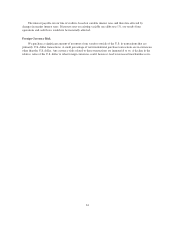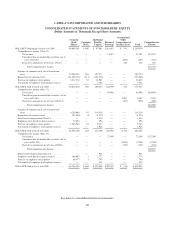Cabela's 2005 Annual Report Download - page 71
Download and view the complete annual report
Please find page 71 of the 2005 Cabela's annual report below. You can navigate through the pages in the report by either clicking on the pages listed below, or by using the keyword search tool below to find specific information within the annual report.transition alternative to calculating the APIC pool. A company may take up to one year from the later of its initial
adoption of Statement 123R or November 11, 2005, to make its election. We are currently evaluating the
transition method for calculating the APIC Pool.
On May 30, 2005, the FASB issued Statement 154, “Change in Accounting Principle” (“Statement 154”),
which changes the requirements for the accounting and reporting of a change in accounting principle. Statement
154 applies to all voluntary changes in accounting principle as well as to changes required by an accounting
pronouncement that does not include specific transition provisions. Statement 154 eliminates the requirement in
APB Opinion No. 20, Accounting Changes, to include the cumulative effect of changes in accounting principle in
the income statement in the period of changes. Instead, to enhance the comparability of prior period financial
statements, Statement 154 requires that changes in accounting principle to be retrospectively applied. Under
retrospective application, the new accounting principle is applied as of the beginning of the first period presented
as if that principle had always been used. The cumulative effect of the change is reflected in the carrying value of
assets and liabilities as of the first period presented and the offsetting adjustments are recorded to opening
retained earnings. Each period presented is adjusted to reflect the period-specific effects of applying the changes.
Statement 154 is effective for accounting changes and corrections of errors made in fiscal years beginning after
December 15, 2005. We do not believe the adoption of Statement 154 will have a material impact on our
financial statements.
On July 14, 2005, the FASB published an exposure draft entitled “Accounting for Uncertain Tax
Positions—an interpretation of FASB Statement No. 109” (“the proposed interpretation”). The proposed
interpretation is intended to reduce the significant diversity in practice associated with recognition and
measurement of income taxes by establishing consistent criteria for evaluating uncertain tax positions. The
proposed interpretation establishes a probable recognition threshold. To recognize a benefit from a tax position, a
company must conclude that the position is probable of being sustained upon audit based solely on the technical
merits of the position. Once the probable recognition threshold is met, the best estimate of the amount that would
be sustained on audit should be recognized. In the period in which it becomes more likely than not that a tax
position would no longer be sustained upon an audit by a taxing authority, the benefit should be derecognized by
recording an income tax liability or reducing a deferred tax asset. A liability arising from the difference between
the position taken in the tax return and the amount booked in the financial statements pursuant to the proposed
interpretation should be classified as a current liability if expected to be paid within one year. However, if the
liability arises from a taxable temporary difference, it would be classified as a deferred tax liability. Companies
should follow the disclosure requirements of Statement 5 for both loss and gain contingencies related to uncertain
tax positions. The transition adjustment resulting from the application of this interpretation would be recorded as
a cumulative-effect change in the income statement as of the end of the period of adoption. The FASB met in
January 2006 and continues to deliberate over the issues in this interpretation, it has also determined that the final
interpretation would not be effective until the first fiscal year ending after December 15, 2006.
In August 2005, the FASB issued proposed statements of financial accounting standards: “Accounting for
Transfers of Financial Assets, an amendment of FASB Statement No. 140” and “Accounting for Servicing of
Financial Assets, an amendment of FASB Statement No. 140.” We are currently reviewing the amendments to
FASB Statement No. 140 and have not yet determined the impact on our financial statements.
In February 2006, the FASB issued Statement No. 155, “Accounting for Certain Hybrid Financial
Instruments—an amendment to FASB Statements No. 133 and 140” (“Statement 155”). Statement 155 eliminates
the exemption from applying Statement 133 to interests in securitized financial assets so that similar instruments
are accounted for similarly regardless of the form of the instruments. It also allows us to elect fair value
measurement at acquisition, at issuance, or when a previously recognized financial instrument is subject to a
remeasurement (new basis) event, on an instrument-by-instrument basis, in cases in which a derivative would
otherwise have to be bifurcated. This statement is effective for all financial instruments acquired or issued after
the beginning of an entity’s first fiscal year that begins after September 15, 2006. Provisions of Statement 155
may be applied to instruments that we hold at the date of adoption on an instrument-by-instrument basis. We are
currently reviewing Statement 155 and have not yet determined the impact on our financial statements.
59
























